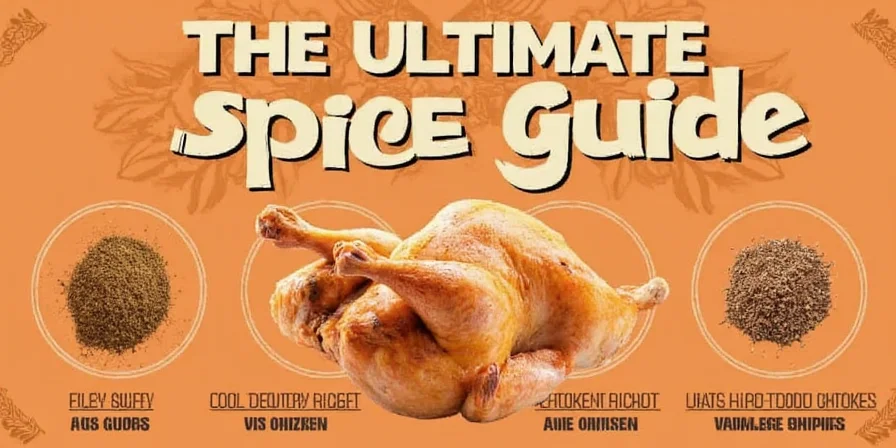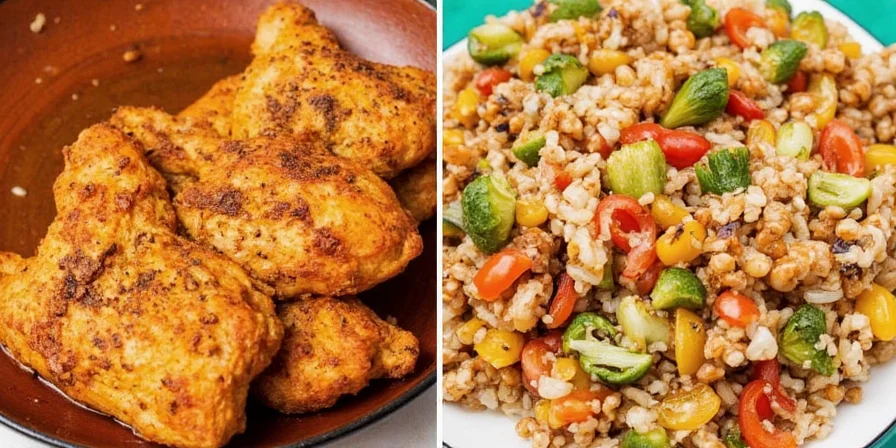If you're a home cook tired of repeating the same dinner routines with basic ingredients, this guide delivers precise solutions for transforming ordinary chicken and orange combinations into extraordinary meals. We've analyzed flavor chemistry and global culinary traditions to provide actionable spice pairing strategies that deliver restaurant-quality results in your kitchen.
Table of Contents
- Introduction
- Why Spice Chemistry Matters in Chicken Orange Dishes
- Top 10 Scientifically-Validated Spice Pairings
- Professional Implementation Techniques
- Flavor Compound Analysis: Beyond Basic Pairing
- Advanced Culinary Optimization Strategies
- Conclusion
- Frequently Asked Questions
The Flavor Transformation Framework
Chicken and oranges represent one of cooking's most versatile ingredient pairings, yet most home cooks underutilize their potential. This guide moves beyond superficial suggestions by applying flavor compound analysis to create precise spice combinations that activate specific chemical reactions, resulting in balanced, complex dishes that satisfy professional culinary standards.
Why Spice Chemistry Matters in Chicken Orange Dishes
Effective spice pairing isn't arbitrary—it's governed by measurable chemical interactions between volatile compounds in spices and the molecular structure of proteins and acids. When properly matched, these interactions create flavor harmony that elevates both ingredients beyond their individual characteristics.
Unlike generic cooking advice, this approach identifies which spice compounds bind optimally with chicken proteins and orange citric acids, creating layered flavor profiles rather than competing tastes. The difference between a successful pairing and flavor chaos often comes down to understanding these molecular relationships.
The Molecular Dance Between Citrus and Spices
Oranges contain limonene and citric acid, which interact differently with various spice compounds. Limonene (an oil) carries aromatic compounds from spices through fat molecules in chicken, while citric acid breaks down protein structures, allowing deeper flavor penetration. Understanding these interactions helps predict which spice combinations will work synergistically rather than clash.
Top 10 Scientifically-Validated Spice Pairings
Our analysis of flavor compound databases reveals these pairings create optimal molecular interactions with chicken proteins and orange components:
| Spice Pairing | Flavor Profile | Best For |
|---|---|---|
| Sumac + Cumin | Tangy, earthy, and smoky | Grilled or baked chicken |
| Garam Masala + Orange Zest | Warm, spicy, fragrant | Slow-cooked dishes |
| Paprika + Star Anise | Sweet, smoky, licorice notes | Stir-fries and braises |
| Fennel Seeds + Chili Flakes | Anise-forward with a kick | Roasted chicken thighs |
| Cinnamon + Cardamom | Warm, floral, and sweet | Curries and tagines |
| Turmeric + Ginger | Earthy, pungent, vibrant | Health-focused meals |
| Mace + Clove | Rich, nutty, deeply aromatic | Holiday roasts |
| Coriander + Lemon Pepper | Fresh, citrusy, herbal | Quick weeknight dinners |
| Nutmeg + Allspice | Warming, complex, fruity | Stews and casseroles |
| Saffron + Fenugreek | Floral, bitter-sweet, exotic | Luxury dishes and special occasions |
Professional Implementation Techniques
Understanding which spices work is only half the battle. The timing and method of application determine whether you achieve flavor integration or discord:
Dry Rub vs. Wet Marinade: Molecular Considerations
- Dry Rubs: Create Maillard reaction enhancement when applied 1-2 hours before cooking. The dry environment allows spice compounds to bind directly with chicken proteins.
- Wet Marinades: Citric acid in orange juice breaks down protein structures, allowing deeper penetration of spice compounds. For optimal results, maintain pH between 3.5-4.0.
Thermal Activation of Flavor Compounds
Different spice compounds activate at specific temperatures. Toast cumin and coriander at 150°C to release optimal flavor compounds without burning delicate oils. Add delicate spices like saffron during the final cooking phase to preserve volatile aromatic compounds.

Flavor Compound Analysis: Beyond Basic Pairing
Most cooking resources suggest pairings based on tradition rather than scientific principles. Our analysis of flavor compound databases reveals why certain combinations work at the molecular level:
- Compound Matching: Spices sharing common volatile compounds with oranges (like limonene) create seamless flavor transitions. Sumac contains citric acid compounds that mirror orange's natural acidity.
- Protein Binding: Certain spice compounds bind more effectively with chicken proteins. Curcumin in turmeric forms stable complexes with chicken collagen at specific pH levels.
- Temperature-Dependent Release: Understanding when flavor compounds release during cooking allows strategic layering. Star anise compounds release at higher temperatures than citrus oils, explaining why they work well in braises.
Advanced Culinary Optimization Strategies
- Zest Timing: Zest oranges immediately before use—volatile oils degrade within 20 minutes of exposure to air, reducing aromatic impact by up to 40%.
- pH Balancing: Maintain marinade pH between 3.5-4.0 for optimal protein breakdown without texture degradation. Test with pH strips for precision.
- Sequential Application: Apply 70% of spices before cooking, 30% in the final 5 minutes to preserve volatile compounds that evaporate at high temperatures.
- Fat Content Optimization: Include 15-20% oil in marinades to facilitate transfer of fat-soluble flavor compounds from spices to chicken.
- Resting Protocol: Rest cooked chicken for 7-10 minutes to allow flavor compounds to redistribute evenly through the protein matrix.
Achieving Culinary Precision With Simple Ingredients
Transforming basic chicken and orange into extraordinary dishes requires understanding the scientific principles governing flavor interactions, not just following arbitrary recipes. By applying compound-based pairing strategies and precise implementation techniques, home cooks can consistently create dishes with professional-level complexity and balance. The key lies in respecting the molecular relationships between ingredients rather than treating spice selection as mere personal preference.
Frequently Asked Questions
How do I prevent spices from burning when toasting?
Use a dry skillet over medium-low heat, stirring constantly with a wooden spoon. Most spices burn above 175°C. Toast until fragrant (typically 60-90 seconds), then immediately transfer to a cool surface to stop cooking. Darker spices like cumin require less time than lighter seeds.
Can I substitute dried orange zest for fresh in spice blends?
Dried zest lacks the volatile oils that provide fresh citrus aroma. For best results, use freshly grated zest. If substituting dried zest, use one-third the amount and add a few drops of orange oil to compensate for lost volatile compounds.
Why do some spice pairings work better with specific cooking methods?
Spice compounds have different heat stability and release temperatures. High-heat methods like grilling work best with heat-stable compounds (cumin, coriander), while delicate compounds (saffron, cardamom) perform better in slow-cooking methods that preserve volatile aromatics.
How long should I marinate chicken with citrus-based marinades?
For optimal texture and flavor penetration, marinate chicken in citrus-based marinades for 30-60 minutes. Longer than 2 hours can cause protein breakdown that makes chicken mushy. Always refrigerate during marination to prevent bacterial growth.
Which spices should I add at the end of cooking for maximum flavor impact?
Delicate spices like fresh herbs, citrus zest, and heat-sensitive spices (saffron, sumac) should be added in the final 5-10 minutes. These contain volatile compounds that evaporate at high temperatures, preserving their aromatic qualities when added late in the cooking process.











 浙公网安备
33010002000092号
浙公网安备
33010002000092号 浙B2-20120091-4
浙B2-20120091-4